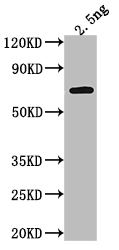Immunization of a rabbit with the recombinant Saccharomyces cerevisiae (strain ATCC 204508 / S288c) (Baker's yeast) RRP6 protein stimulates its immune system to produce antibodies against the RRP6 protein. Once a sufficient amount of antibodies is generated, a serum sample is collected to obtain polyclonal antibodies. The RRP6 antibody undergoes protein A/G affinity chromatography purification. The effectiveness of the RRP6 antibody is assessed through ELISA and WB applications. This specific RRP6 antibody exhibits the ability to specifically react with the Saccharomyces cerevisiae (strain ATCC 204508 / S288c) (Baker's yeast) RRP6 protein.
The Saccharomyces cerevisiae RRP6 protein mainly participates in the degradation and processing of various RNA molecules, which helps maintain the stability and integrity of the cellular RNA pool. RRP6 is a component of the exosome complex, which is involved in RNA surveillance and quality control. It plays a crucial role in the degradation of non-coding RNA, such as rRNA, tRNA, snRNA, and snoRNA. Additionally, RRP6 is also involved in the degradation of certain mRNA molecules.





